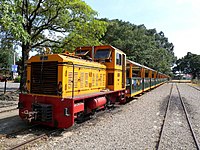Houbi
|
Houbi 後壁 區 |
||
 Location of Houbi in Tainan |
||
| State : |
|
|
| Coordinates : | 23 ° 22 ' N , 120 ° 21' E | |
| Area : | 72.2189 km² | |
| Residents : | 23,346 (Dec 2018) | |
| Population density : | 323 inhabitants per km² | |
| Time zone : | UTC + 8 (Chungyuan time) | |
| Telephone code : | (+886) (0) 6 | |
| Postal code : | 731 | |
| ISO 3166-2 : | TW-TNN | |
| Community type : | Municipality of Tainan | |
| Structure : | 14 districts ( 里 , Lǐ ) | |
| Website : | ||
|
|
||
Houbi ( Chinese 後壁區 , Pinyin Houbi Qū , W.-G. Hou 4 -pi 4 Ch'ü 1 , PEH OE jī Au Piah-khu ) is a district of the centrally-administered city of Tainan in the south west of the Republic of China on Taiwan .
description
Houbi is located on the northern edge of the urban area of Tainan in the northern part of the Jianan Plain . Geologically, Houbi is essentially an alluvial plain of the Bazhang ( 八掌溪 ) and Jishui ( 急水溪 ) rivers . The former forms for the most part the northern boundary of the municipality. Adjacent are the districts of Baihe in the east, Dongshan in the southeast, and Xinying and Yanshui in the southwest, and in the neighboring district of Chiayi, the communities of Yizhu , Lucao and Shuishang .
history
The original inhabitants of the area were members of the indigenous Austronesian peoples of Taiwan . With the annexation of the island of Taiwan to the Chinese Empire in 1684, the continuous immigration of Han Chinese began , especially from the coastal provinces of Fujian and Guangdong . Administratively, the Houbi area initially belonged to Zhuluo County ( 諸 羅 縣 ). In 1895 Taiwan came under Japanese rule and from 1920 Houbi was part of Tainan Prefecture . After Taiwan was transferred to the Republic of China in 1945, Houbi became a rural community ( 鄉 , Xiāng ) in the newly established Tainan County in 1946 . The county was dissolved with effect from December 25, 2010 and incorporated into the city of Tainan. All district parishes were then given the status of urban districts ( 區 , Qū ).
| Outline by Houbi |
administration
An administrative reform took place on April 30, 2018, in which the previously 21 districts were merged into 14:
1. Houbi ( 後壁 里 )
2. Houbo ( 侯 伯里 )
3. Jiadong ( 嘉 苳 里 )
4. Tugou ( 土 溝里 )
5 Shangjiadong ( 上 茄 苳 里 )
6 Jingfeng ( 菁 豐 里 )
7. Jingliao ( 菁 寮里 )
8. Xinjia ( 新 嘉 里 )
9. Changduangshu ( 長短 樹 里 )
10. Zhuxin ( 竹 新 里 )
11. Xindong ( 新 東 里 )
12. Dingan ( 頂 安 里 )
13 Chang'an ( 長安 里 )
14. Fu'an ( 福安 里 )
traffic
The district is crossed by the national road 1 (motorway) running in a north-northeast direction. Provincial Road 1 runs almost parallel to it a few kilometers further east. Two railway lines run through Houbi essentially in a north-south direction: on the one hand the southern longitudinal line ( 縱貫 線 ) of the Taiwanese Railway near Provincial Road 1, and on the other hand the high-speed rail Taiwan high speed rail . The former has a train station in Houbi.
Agriculture
The economic structure of Houbis is characterized by agriculture. Wet rice cultivation is dominant and occupies 3500 hectares. The main types of fruit that are grown are real guava and cantaloupe melon . In addition, orchids are cultivated ( Phalaenopsis ). The Taiwan Orchid Biotechnology Park ( 臺灣 蘭花 生物 科技 園區 ), where international orchid exhibitions are held, is located on the site of a former sugar factory .
Sightseeing and tourism
The Tai'an Temple ( 泰安 宮 ) in the Jiayu district is well worth seeing . It is dedicated to the sea goddess Mazu . The temple was built in 1791, but has been redesigned many times since then. The old Jingliao Huang building ( 菁 寮 黃 家 古厝 ) was built in the eclectic "Western" style in 1928 during the Japanese colonial era . In the Xiaonanhai nature reserve ( 小 南海 風景區 ) you can go on bike trips or short hikes. On the grounds of the former sugar factory, narrow-gauge railways are in operation for tourist purposes.
Web links
Individual evidence
- ↑ Natural Environment. Houbi's website, accessed January 10, 2019 .
- ↑ 地方 沿革 ("Development of the place"). Houbi's website, accessed January 10, 2019 (Chinese).
- ↑ 村里 介紹 ("introduction to the village"). Houbi's website, accessed January 10, 2019 (Chinese).
- ↑ 後壁 區 行政區 圖 (Administrative map of the Houbi area). Houbi's website, accessed January 10, 2019 (Chinese).
- ↑ 本 區 特產 (“Special products from the region”). Houbi's website, accessed January 10, 2019 (Chinese).
- ↑ 風景 名勝 ("Scenic Sights"). Houbi's website, accessed January 10, 2019 (Chinese).
- ↑ 小 南海 風景區 ("Xiaonanhai Conservation Area"). Tainan Office for Tourism and Tourism, accessed January 10, 2019 (Chinese).
- ↑ 台糖 烏 樹林 園區 ("Tai Sugar Forest Park"). Tainan Office for Tourism and Tourism, accessed January 10, 2019 (Chinese).




